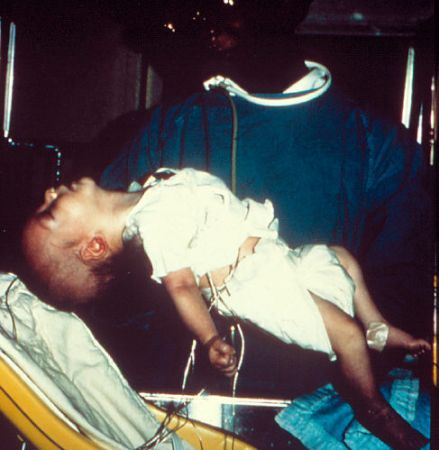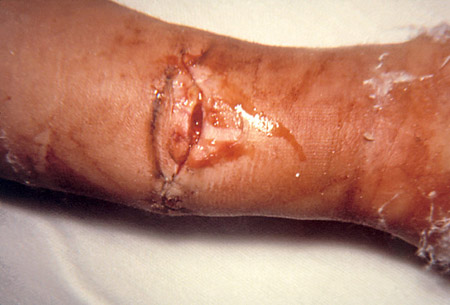Cases of botulism are more common in the US than in the UK.
Spores of Clostridium botulinum are ubiquitous. In the US, 60% of cases east of the Mississippi river are due to B toxin, while west of the river, 85% of cases are due to A toxin.[1]Centers for Disease Control and Prevention, National Center for Infectious Diseases, Division of Bacterial and Mycotic Diseases. Botulism in the United States, 1899-1996: handbook for epidemiologists, clinicians, and laboratory workers. Atlanta, GA: Centers for Disease Control and Prevention; 1998.
https://www.cdc.gov/botulism/pdf/bot-manual.pdf
Infant botulism, the most common form, occurs with toxin types A, B, or F. In 2017 there were 141 confirmed or probable paediatric cases in the US.
CDC: national botulism surveillance
Opens in new window A total of 2419 infant cases were reported in the US from 1976 to 2006.[2]Koepke R, Sobel J, Arnon SS. Global occurrence of infant botulism, 1976-2006. Pediatrics. 2008 Jul;122(1):e73-82.
http://www.ncbi.nlm.nih.gov/pubmed/18595978?tool=bestpractice.com
Over this time span, an additional 524 cases of infant botulism were identified globally.[2]Koepke R, Sobel J, Arnon SS. Global occurrence of infant botulism, 1976-2006. Pediatrics. 2008 Jul;122(1):e73-82.
http://www.ncbi.nlm.nih.gov/pubmed/18595978?tool=bestpractice.com
Rare cases of infant botulism due to toxin E production by Clostridium butyricum, or toxin F production by Clostridium baratii, have also been reported.[3]Giménez JA, Giménez MA, DasGupta BR. Characterization of the neurotoxin isolated from a Clostridium baratii strain implicated in infant botulism. Infect Immun. 1992 Feb;60(2):518-22.
http://iai.asm.org/content/60/2/518.full.pdf+html
http://www.ncbi.nlm.nih.gov/pubmed/1730484?tool=bestpractice.com
[4]Suen JC, Hatheway CL, Steigerwalt AG, et al. Genetic confirmation of identities of neurotoxigenic Clostridium baratii and Clostridium butyricum implicated as agents of infant botulism. J Clin Microbiol. 1988 Oct;26(10):2191-2.
http://jcm.asm.org/content/26/10/2191.full.pdf+html
http://www.ncbi.nlm.nih.gov/pubmed/3183004?tool=bestpractice.com
In England and Wales between 1975 and 2013, 16 cases of infant botulism were reported.[5]Health Protection Agency. Infant botulism: laboratory reported cases of Clostridium botulinum intoxication reported to the Health Protection Agency Centre for Infections England and Wales 1975-2013. January 2014 [internet publication].
http://webarchive.nationalarchives.gov.uk/20140714084352/http://www.hpa.org.uk/Topics/InfectiousDiseases/InfectionsAZ/Botulism/EpidemiologicalData/botu020InfantBotulismLaboratoryreportedcases
Foodborne botulism, attributed to A, B, or E toxin, is most frequently seen in an outbreak setting. Although commercially tinned foods were commonly the source of foodborne illness in the early 1900s, home-preserved vegetables, fruits, and fish products are now the most common sources.[6]Gottlieb SL, Kretsinger K, Tarkhashvili N, et al. Long-term outcomes of 217 botulism cases in the Republic of Georgia. Clin Infect Dis. 2007 Jul 15;45(2):174-80.
http://cid.oxfordjournals.org/content/45/2/174.full
http://www.ncbi.nlm.nih.gov/pubmed/17578775?tool=bestpractice.com
In some cultures, such as among the indigenous people of Alaska, preferred food preparation practices involving fish fermentation commonly lead to botulism.[7]Shaffer N, Wainwright RB, Middaugh JP, et al. Botulism among Alaska natives. The role of changing food preparation and consumption practices. West J Med. 1990 Oct;153(4):390-3.
http://www.ncbi.nlm.nih.gov/pmc/articles/PMC1002567/pdf/westjmed00110-0040.pdf
http://www.ncbi.nlm.nih.gov/pubmed/2244373?tool=bestpractice.com
In China, homemade fermented beans are the leading cause.[8]Gao QY, Huang YF, Wu JG, et al. A review of botulism in China. Biomed Environ Sci. 1990 Sep;3(3):326-36.
http://www.ncbi.nlm.nih.gov/pubmed/2252552?tool=bestpractice.com
Commercial foods and restaurants are still occasional sources.[9]Centers for Disease Control and Prevention (CDC). Botulism associated with commercially canned chili sauce - Texas and Indiana, July 2007. MMWR Morb Mortal Wkly Rep. 2007 Aug 3;56(30):767-9.
http://www.cdc.gov/mmwr/preview/mmwrhtml/mm5630a4.htm
http://www.ncbi.nlm.nih.gov/pubmed/17673898?tool=bestpractice.com
In the US, 263 cases of foodborne botulism occurred from 1990 to 2000 (17-43 cases per year).[10]Sobel J, Tucker N, Sulka A, et al. Foodborne botulism in the United States, 1990-2000. Emerg Infect Dis. 2004 Sep;10(9):1606-11.
http://www.ncbi.nlm.nih.gov/pubmed/15498163?tool=bestpractice.com
In 2017, 19 cases of foodborne intoxication were reported in the US.
CDC: national botulism surveillance
Opens in new window Foodborne illness has been reported throughout the US, but over half of cases (54%) have occurred in just 5 western states (California, Washington, Oregon, Colorado, and Alaska).[1]Centers for Disease Control and Prevention, National Center for Infectious Diseases, Division of Bacterial and Mycotic Diseases. Botulism in the United States, 1899-1996: handbook for epidemiologists, clinicians, and laboratory workers. Atlanta, GA: Centers for Disease Control and Prevention; 1998.
https://www.cdc.gov/botulism/pdf/bot-manual.pdf
Foodborne botulism is uncommon in the UK; only 62 cases were reported from 1922 to 2005.[11]McLauchlin J, Grant KA, Little CL. Food-borne botulism in the United Kingdom. J Public Health (Oxf). 2006 Dec;28(4):337-42.
http://jpubhealth.oxfordjournals.org/content/28/4/337.full
http://www.ncbi.nlm.nih.gov/pubmed/16917124?tool=bestpractice.com
More cases are seen in southern and eastern Europe, where it is more common to preserve foods at home.[12]Health Protection Agency. Guidelines for action in the event of a deliberate release: botulism. 31 March 2009 [internet publication].
http://webarchive.nationalarchives.gov.uk/20140714084352/http://www.hpa.org.uk/webc/HPAwebFile/HPAweb_C/1194947315628
[13]European Centre for Disease Prevention and Control: surveillance atlas of infectious diseases - botulism
https://atlas.ecdc.europa.eu/public/index.aspx?Dataset=27&HealthTopic=7
In England and Wales between 1980 and 2013, there were 36 reported cases of foodborne botulism, with 3 reported as resulting in deaths. Of these cases, in 1989 an outbreak of 26 cases were due to contaminated hazelnut yoghurt.[14]Health Protection Agency. Foodborne botulism: laboratory reported cases of Clostridium botulinum intoxication reported to the Health Protection Agency Centre for Infections England and Wales 1980-2013. January 2014 [internet publication].
http://webarchive.nationalarchives.gov.uk/20140714084352/http://www.hpa.org.uk/Topics/InfectiousDiseases/InfectionsAZ/Botulism/EpidemiologicalData/botu010FoodborneBotulismLaboratoryreportedcases
Wound botulism is due to A or B toxin and is the result of wound contamination by C botulinum spores. It has been associated almost exclusively with injection drug users of 'black tar' heroin.[15]Werner SB, Passaro D, McGee J, et al. Wound botulism in California, 1951-1998: a recent epidemic in heroin injectors. Clin Infect Dis. 2000 Oct;31(4):1018-24.
http://cid.oxfordjournals.org/content/31/4/1018.long
http://www.ncbi.nlm.nih.gov/pubmed/11049786?tool=bestpractice.com
[16]Passaro DJ, Werner SB, McGee J, et al. Wound botulism associated with black tar heroin among injecting drug users. JAMA. 1998 Mar 18;279(11):859-63.
http://jama.jamanetwork.com/article.aspx?articleid=187346
http://www.ncbi.nlm.nih.gov/pubmed/9516001?tool=bestpractice.com
[17]Peak CM, Rosen H, Kamali A, et al. Wound botulism outbreak among persons who use black tar heroin - San Diego County, California, 2017-2018. MMWR Morb Mortal Wkly Rep. 2019 Jan 4;67(5152):1415-8.
https://www.cdc.gov/mmwr/volumes/67/wr/mm675152a3.htm
http://www.ncbi.nlm.nih.gov/pubmed/30605447?tool=bestpractice.com
In England and Wales from 2000 to 2013, 147 suspected cases of wound botulism were reported. Eight deaths were recorded between 2003 and 2013.[18]Health Protection Agency. Wound botulism in people who inject drugs: suspected and confirmed cases reported to the Health Protection Agency Centre for Infections, England and Wales 2000-2013. January 2014 [internet publication].
http://webarchive.nationalarchives.gov.uk/20140714084352/http://www.hpa.org.uk/Topics/InfectiousDiseases/InfectionsAZ/Botulism/EpidemiologicalData/botu040WoundbotulismsuspectedcasesreportedtotheHPA
Inhalational botulism does not occur in nature; an unusual toxin type (i.e., C, D, F, or G) or symptoms among patients with a common geographical factor may suggest an act of bioterrorism.
Botulinum toxin types A and B have been approved by the US Food and Drug Administration for cosmetic and therapeutic purposes (e.g., blepharospasm, strabismus, cervical dystonia). Iatrogenic botulism cases have been reported with the therapeutic and unlicensed cosmetic use of botulinum toxin A.[19]Crowner BE, Brunstrom JE, Racette BA. Iatrogenic botulism due to therapeutic botulinum toxin A injection in a pediatric patient. Clin Neuropharmacol. 2007 Sep-Oct;30(5):310-3.
http://www.ncbi.nlm.nih.gov/pubmed/17909312?tool=bestpractice.com
[20]Chertow DS, Tan ET, Maslanka SE, et al. Botulism in 4 adults following cosmetic injections with an unlicensed, highly concentrated botulinum preparation. JAMA. 2006 Nov 22;296(20):2476-9.
http://jama.jamanetwork.com/article.aspx?articleid=204211
http://www.ncbi.nlm.nih.gov/pubmed/17119144?tool=bestpractice.com
[21]Souayah N, Karim H, Kamin SS, et al. Severe botulism after focal injection of botulinum toxin. Neurology. 2006 Nov 28;67(10):1855-6.
http://www.ncbi.nlm.nih.gov/pubmed/17130423?tool=bestpractice.com
[Figure caption and citation for the preceding image starts]: Six-week-old infant with botulismCenters for Disease Control and Prevention (CDC) [Citation ends]. [Figure caption and citation for the preceding image starts]: Wound botulism involvement of compound fracture of right armCenters for Disease Control and Prevention (CDC) [Citation ends].
[Figure caption and citation for the preceding image starts]: Wound botulism involvement of compound fracture of right armCenters for Disease Control and Prevention (CDC) [Citation ends].
 [Figure caption and citation for the preceding image starts]: Wound botulism involvement of compound fracture of right armCenters for Disease Control and Prevention (CDC) [Citation ends].
[Figure caption and citation for the preceding image starts]: Wound botulism involvement of compound fracture of right armCenters for Disease Control and Prevention (CDC) [Citation ends].